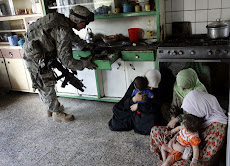

 [Photo] People wade through a flooded road in Mumbai, India. Photograph: Gautam Singh/AP
[Photo] People wade through a flooded road in Mumbai, India. Photograph: Gautam Singh/APAugust 3rd: Monsoon rains whipped the Indian subcontinent yesterday, flooding a wide swathe south of the Himalayas and bringing the death toll over recent weeks to more than 1,100, with 19 million people displaced. Hundreds of kilometres of land from the Gangetic plains to the Bangladeshi delta are under water as rivers burst their banks, although most of the deaths have happened in central India. Parts of the Indian states of Assam, Bihar and Uttar Pradesh have seen almost three weeks of rain, swelling rivers and flooding fields.
The country's financial capital, Mumbai, saw water levels rise to knee level in the streets, forcing train services to be closed down and flights to be cancelled.In recent days, 60 people have lost their lives in Bangladesh, while flooding and landslides have caused 84 deaths in Nepal. Farming, the lifeline of rural India, has been severely affected, and relief workers have warned that food stocks, as well as drinking water supplies, are perilously low. Millions of people have been cut off from the rest of the country, and the floods have destroyed crops worth millions of rupees. More than 14 million people in India, and another five million in Bangladesh, have been affected.
Aid agencies say health issues are of particular concern, with reports of fever, acute respiratory infections, diarrhoea and snake bites among refugees.With the fertile plains south of the Himalayas now covered with water, the Indian army has been deployed to evacuate people from affected regions. In many remote areas, hundreds of thousands have scrambled to find shelter on higher ground, setting up temporary dwellings.In Uttar Pradesh, India's most populous state, more than 500 villages are below the water line, and 100,000 displaced people are living in relief camps in Assam.  In Bangladesh, at least one third of the country's 64 districts have been partly submerged by the flooding.Farmer Rahmat Sheikh and his family were among the 2,000 villagers who fled their flooded village in Sirajganj district, Bangladesh. "The floods have taken away all I had," 40-year-old Mr Sheikh told the Associated Press. "Rice paddies in the field, two cows and my house all are gone. I don't know how we will now survive." Aid agencies were gearing up for a huge rescue operation. Unicef, the UN's chidren's fund, said in a statement that the "sheer size and scale of flooding and massive numbers of people affected poses an unprecedented challenge to the delivery of desperately needed humanitarian assistance by governments".
In Bangladesh, at least one third of the country's 64 districts have been partly submerged by the flooding.Farmer Rahmat Sheikh and his family were among the 2,000 villagers who fled their flooded village in Sirajganj district, Bangladesh. "The floods have taken away all I had," 40-year-old Mr Sheikh told the Associated Press. "Rice paddies in the field, two cows and my house all are gone. I don't know how we will now survive." Aid agencies were gearing up for a huge rescue operation. Unicef, the UN's chidren's fund, said in a statement that the "sheer size and scale of flooding and massive numbers of people affected poses an unprecedented challenge to the delivery of desperately needed humanitarian assistance by governments".
The torrential rains began last month, and last until September. The monsoon is vital to the region's rural economy, bringing both hope and fear. Despite being a regular event, hundreds lose their lives every year in landslides and by drowning.With swollen rivers bursting their banks after days of rain, that danger is again being made clear on the fertile plans of India, which provide food for hundreds of millions of people. In New Delhi, India's meteorological department told Reuters that unusual monsoon patterns this year had led to heavier rains than normal. "We've been getting constant rainfall in these areas for nearly 20 days," BP Yadav, a spokesman for the department, said. Some blame India for worsening the situation because it has released water building up in its river system. However, politicians in India say countries such as Nepal have a responsibility to regulate water flow.Experts argue that such finger-pointing allows officials to dodge the truth that bad management and poor planning have led to avoidable death and damage.
Himanshu Thakkar, the co-ordinator of the South Asia Network of Dams, Rivers and People, said water levels in dams in India were too high, with no room to capture rainfall. Mr Thakkar also pointed out that embankments burst after just a few days of heavy rainfall, suggesting poor maintenance. "There's no effective water catchment management in place," he said. "You need systems in place like a proper drainage network to flush this water away - especially in cities. But nowhere in the region has bothered. "Now climate change models predict heavier rainfall events happening more frequently. Has there been a change in attitude? No."
+++++++++++++++++++++++++++++++++++++++++++++++++++
Disclaimer
No responsibility or liability shall attach itself to either myself or to the blogspot ‘Mozlink’ for any or all of the articles/images placed here. The placing of an article does not necessarily imply that I agree or accept the contents of the article as being necessarily factual in theology, dogma or otherwise.
Mozlink





















































No comments:
Post a Comment